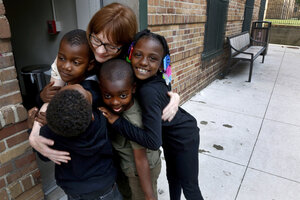In Chicago, dismantling segregation through art
In a deeply divided neighborhood of Chicago, white and black families traditionally didn't mingle. But that's beginning to change after the arrival of Art on Sedgwick, an art studio that has become somewhat of a community center.

Charlie Branda, founder of Art on Sedgwick, hugs a few young residents of Marshall Field Garden Apartments in Chicago. Ms. Branda, whom many children call 'art teacher,' is a former commercial banker who left the profession to raise her two children, now teens.
Martha Irvine/AP
Chicago
Charlie Branda is not an artist. When she opened an art studio on a stretch of asphalt known as Sedgwick Street, the mom and former commercial banker simply wanted to get to know her neighbors and to connect two sides of a thoroughfare that divides black and white, haves and have-nots. "The way it is now isn't the way it has to be," she remembers thinking.
Ms. Branda had lived for years in and around Chicago's Old Town neighborhood when she, her husband, and two children moved into a red-brick house on the east, and wealthier, side of Sedgwick in 2008.
Initially, she joined with her neighbors to demand that the city, police, and absentee landlords do something about drug-dealing and occasional gunfire in the neighborhood. But she also spent a lot of time walking around, ignoring those who advised her to stay on "her side" of the street.
"Hello!" she'd chirp, smiling as she greeted strangers from Marshall Field Garden Apartments, a subsidized complex on the west side of Sedgwick.
Then in 2013, a young African-American father was fatally shot while on his way to buy diapers, just steps from the Brandas' home. Some residents were ready to move, and at least one family eventually did. But Branda couldn't shake the idea that she didn't even know the family that had lost a loved one.
"She saw us as neighbors," says Adell Thomas, a longtime resident of Marshall Field and president of its tenants' association.
Branda had been reading a book – "Make the Impossible Possible" by William Strickland Jr., a community activist in Pittsburgh who credits a high school art teacher with helping him find his way in life. She kept thinking about an image Mr. Strickland described: a ball of clay and how "you can make a miracle with your hands," she recalls.
She began telling people about her vision for a neighborhood art studio, and eventually presented the idea at community meetings. Ms. Thomas was inspired and quickly decided: "I want to be part of that." As she got to know Branda, Thomas was surprised to learn she'd grown up in Anchorage, Alaska, with a single mom and modest means. Branda, meanwhile, saw a bit of her tough yet compassionate mom in Thomas.
A board was formed, and in October 2015, the first Art on Sedgwick studio opened in a tiny storefront across the street from Marshall Field Garden Apartments. That day, neighbors stopped to write on a large chalkboard outside the studio that had rows of the unfinished sentence, "Before I die, I want to ______."
"Do Art," one girl wrote. And so it began.
The first classes, including cartoon drawing and embroidery, were small but consistently attended. The victories also were small but satisfying. It started with "just showing up," says Cory Stutts, middle school director at the private Catherine Cook School, two blocks east of Sedgwick Street.
Last year, an effort known informally as "the kite project" brought together sixth-graders from Catherine Cook and Manierre Elementary, a public school tucked behind the Marshall Field apartments. The kids were paired off and instructed to interview one another, asking questions like: "What do you dream about?" ''Do you think about dying?" ''Are you scared?" Then came a portrait session; the photos then were made into kites.
"A group of white kids and black kids playing together – you really don't see that nowadays," marveled Manierre student Eric Evans.
With each art show, class and community event, more people have trickled into Art on Sedgwick. One Saturday each month, a faithful group of adults from varied backgrounds gathers at the studio for a "Sip and Paint," a chance to do art, chat, and drink a little wine. Branda and Thomas, now friends, often take part.
"In some ways, I feel like we've accomplished so much in terms of building community and maybe changing the discussion," Branda says. "On the other hand, I feel like we've just barely scratched the surface."
There are people on both sides of Sedgwick who aren't so sure the neighborhood's divides can be bridged. Even as property values on his side of the street have increased, Branda's next-door neighbor, Jerry Capell, says the disconnect is "as wide as it's ever been," and that saddens him.
From her apartment on the other side of the street, Eric Evans' mother, Sherise McDaniel, also still sees very separate worlds.
"I would consider Charlie the exception. Charlie is like a vein connecting those people to us and us to them," says Ms. McDaniel, who is African-American and a special education aide at a high school. "I love this neighborhood. ... I love this city. I wish it loved me back."
Branda still walks the neighborhood and greets residents, many of whom know her now. "You can't 'un-connect' us," she insists.
She gets teary when she says this. "I think I'm tired of the divisiveness," she explains.
A while later, outside the Art on Sedgwick studio, a few kids from Marshall Field run to hug her, as they often do.
"Hi, art teacher! Hi, art teacher!" they shout. Branda wraps her arms around all of them, closing her eyes as she squeezes tightly.
She still doesn't consider herself an art teacher.
But she is their neighbor.
This story was reported by The Associated Press.

